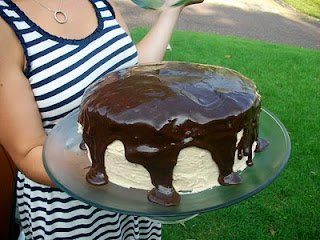
Like I always say, the right tool for the job is essential to actually finishing it (and keeping your sanity). On the other hand, the right tool for the job is oftentimes expensive. Seeing as I didn't own a sledge hammer (and I'm cheap), we started the job with a normal hammer. After 10 minutes or so, I could tell it was gonna be impossible to finish the job in a timely manner with that wimpy little thing. In lieu of a sledge hammer, I decided to use my heavy duty axe (bought back when I thought I could take out the huge stump in our backyard with it - hah!). It's pretty heavy, and the back end is blunt, so it worked pretty well.

Here you can really see the construction of the wall. It's heavy duty. There are arguably 4 layers, including at least 2 inches of what Ask The Builder calls "Cement Mud" behind the tile. It's all laid on top of a metal lathe that was attached to the studs with a small piece of plasterboard (for an extra bump out). Believe me when I say it feels like hitting a thick cement wall.
Although the axe wasn't a bad solution (see: free), I really could use a sledge hammer. Luckily, we went garage sale-ing Saturday and I found one for $6-8, depending on how you count (I got $12 worth of tools for $10 -- the sledge hammer, a thin margin trowel, and a crow bar). When I got it home, I sanded the haft down smooth (220 grit) and put new "grips" on it with duck tape. Watch out, Wall!
























